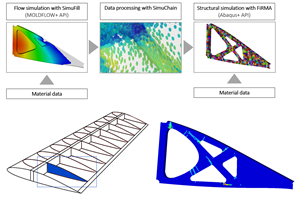New Lorenz BMC, SMC pass Euro rail fire standards
A new fire protection standard for German rail transport, DIN EN 45545-2, put forth by DIN (Berlin, Germany) now will regulate and standardize the fire protection requirements on a European level. To meet the new requirement, Lorenz Kunststofftechnik developed two new thermoset molding compounds, BMC 0204 and SMC 0208.
To protect public safety, fire risk is carefully considered by European train manufacturers and their suppliers. “Different requirements apply for railway vehicles than for buildings,” explains Thomas Lorenz, managing director of the Lorenz Kunststofftechnik GmbH (Wallenhorst, Germany). “They require the use of different plastics, and pose difficulties for manufacturers of material and components.” A new fire protection standard for German rail transport, DIN EN 45545-2, put forth by DIN (Berlin, Germany) now will regulate and standardize the fire protection requirements on a European level so that interoperability in the trans-European high-speed traffic as well as the safety of rail passengers will be guaranteed. The fire protection standards for railway vehicles have been tightened, compared to the previous regulations.
To meet the new requirement, Lorenz Kunststofftechnik developed two new thermoset molding compounds, BMC 0204 and SMC 0208. They have been designed to address the broad range of new requirements in rail vehicle construction with regard to their mechanical properties and flame retardant behavior, and are among the first to pass the fire protection test in conformity with the new standard.
The new material test procedures focused on flammability, flame dispersion, and in particular, the development of smoke gas and its density and toxicity. Thermoplastics, the most commonly used material in rail vehicle construction, will not fulfill the new standards in all of these areas, says Lorenz Kunststofftechnik. The company says thermoplastics show extensive smoke development and due to their low softening point, melt too quickly. Especially with critical parts, such properties may become a risk for passengers. Therefore, the new standards consider flammability and flame dispersion (ISO 5668-2), the thermal release rate (ISO 5660-1) and smoke gas density as well as the toxicity of the smoke gas (ISO 5659-2) for the classification of the fire behavior and fire side effects.
To calculate the Hazard Level (HL), on which the requirements of the classification system are based, the operating and construction categories of DIN EN 45545-2 were used, with various fire protection tests required. For example, the material is differentiated into “generally accessible” and “not accessible” areas, based on general range of application inside or outside the train and specific usage, such as furniture or mechanical facilities. Surfaces made of SMC, for example, have been approved for the highest HL tier (HL3).
SMC, available as semi-finished product in rolls, is used where high mechanical strength and stiffness is required. In the rail sector SMC is commonly used for the exterior and interior cladding, window frames, seats and hubcaps. BMC is especially suitable for the production of small parts, for example, light switches or electrical plug connections, as it can be manufactured by compression molding, injection molding, transfer molding and injection-compression molding. Due to its comparative tracking index (CTI) values of 600 volts and a thermal conductivity of 1,35 W/mK, BMC is an excellent insulator for electronic components.
The various fields of application of BMC and SMC at all risk levels help reduce the amount of material used in the rail vehicle construction, due to lighter weight, and thus reduce production and warehousing expense. With regard to the trend to employ more composite components for weight, design and comfort reasons, these new thermosets provide options for many applications thanks to their advantageous fire behavior.
Related Content
Improving carbon fiber SMC simulation for aerospace parts
Simutence and Engenuity demonstrate a virtual process chain enabling evaluation of process-induced fiber orientations for improved structural simulation and failure load prediction of a composite wing rib.
Read MoreBraided thermoplastic composite H2 tanks with co-consolidated molded boss areas to fit EV battery space
BRYSON project demonstrates possible designs, automated manufacturing and low permeability concepts, including EVOH liner and novel PPA matrix.
Read MoreSMC composites progress BinC solar electric vehicles
In an interview with one of Aptera’s co-founders, CW sheds light on the inspiration behind the crowd-funded solar electric vehicle, its body in carbon (BinC) and how composite materials are playing a role in its design.
Read MoreThermoplastic composites: Cracking the horizontal body panel nut
Versatile sandwich panel technology solves decades-long exterior automotive challenge.
Read MoreRead Next
Cutting 100 pounds, certification time for the X-59 nose cone
Swift Engineering used HyperX software to remove 100 pounds from 38-foot graphite/epoxy cored nose cone for X-59 supersonic aircraft.
Read MoreNext-gen fan blades: Hybrid twin RTM, printed sensors, laser shock disassembly
MORPHO project demonstrates blade with 20% faster RTM cure cycle, uses AI-based monitoring for improved maintenance/life cycle management and proves laser shock disassembly for recycling.
Read MoreCeramic matrix composites: Faster, cheaper, higher temperature
New players proliferate, increasing CMC materials and manufacturing capacity, novel processes and automation to meet demand for higher part volumes and performance.
Read More












